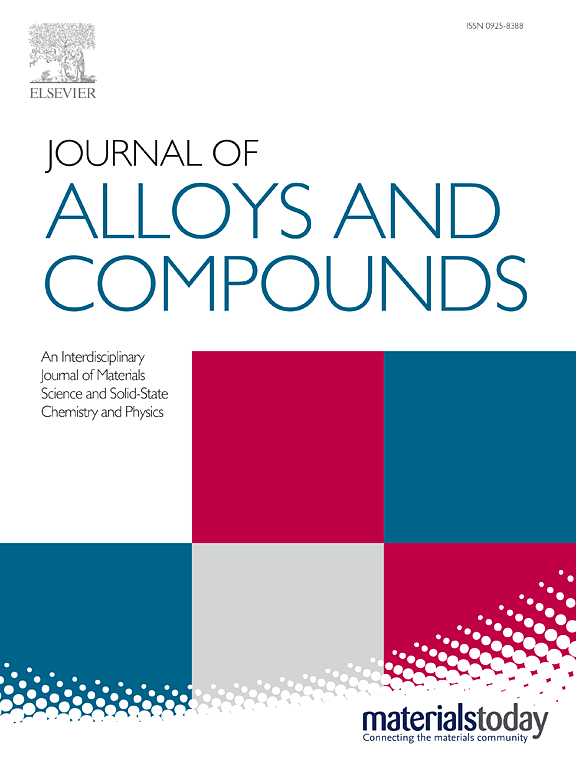Exploring the structural, mechanical and thermodynamic properties of layered Ta3AlC2-type MAX ceramics for ultrahigh-temperature applications
IF 5.8
2区 材料科学
Q2 CHEMISTRY, PHYSICAL
引用次数: 0
Abstract
Ta3AlC2-type MAX carbides with a layer structure are considered promising candidates for ultrahigh-temperature ceramics due to their unique structure features: the M-C layer contributes high melting point and mechanical strength, while the M-Al layer forms a protective antioxidant layer. However, the dynamical stability and overall properties of these Ta3AlC2-type MAX ceramics are unknown. A key challenge, therefore, lies in identifying novel MAX ceramics with excellent comprehensive properties to meet the demands of advancing ultrahigh-temperature industries. To solve these problems, the phase stability, elastic modulus, hardness, elastic anisotropy, and thermodynamic properties of six TM3AlC2 ceramics are systematically studied using first-principles calculations. The results reveal that three new TM3AlC2 ceramics: V3AlC2, Cr3AlC2 and Nb3AlC2 are firstly predicted. Importantly, the calculated bulk modulus of Ta3AlC2 is bigger than that of Cr2AlC and Mo2AlC. In particular, V3AlC2 exhibits the highest elastic modulus among all the studied TM3AlC2 ceramics. Naturally, the high elastic modulus of these carbides is determined by their TM-C-TM-Al layered structure, particularly the cohesive forces between the TM-C layer and TM-Al layer, as reflected by the TM-C bond in TM-C layer and TM-Al bond in TM-Al layer. Finally, the Debye temperature follows the order of V3AlC2>Ta3AlC2>Cr3AlC2>Nb3AlC2>Hf3AlC2>Zr3AlC2. Therefore, this study provides new insight into the structural feature and overall properties of TM3AlC2 MAX ceramics and opens up a promising avenue for seeking the novel TM3AlC2 MAX ceramics suitable for various ultrahigh temperature industries.

探索层状ta3alc2型MAX超高温陶瓷的结构、力学和热力学性能
具有层状结构的ta3alc2型MAX碳化物由于其独特的结构特征而被认为是超高温陶瓷的有前途的候选者:M-C层具有较高的熔点和机械强度,而M-Al层形成保护抗氧化层。然而,这些ta3alc2型MAX陶瓷的动态稳定性和整体性能尚不清楚。因此,关键的挑战在于寻找具有优异综合性能的新型MAX陶瓷,以满足不断发展的超高温工业的需求。为了解决这些问题,采用第一性原理计算方法系统地研究了6种TM3AlC2陶瓷的相稳定性、弹性模量、硬度、弹性各向异性和热力学性能。结果表明,首次预测了三种新型TM3AlC2陶瓷:V3AlC2、Cr3AlC2和Nb3AlC2。重要的是,计算得到的Ta3AlC2的体积模量大于Cr2AlC和Mo2AlC。在TM3AlC2陶瓷中,V3AlC2具有最高的弹性模量。当然,这些碳化物的高弹性模量是由它们的TM-C-TM-Al层状结构决定的,特别是TM-C层与TM-Al层之间的粘结力,体现在TM-C层中的TM-C键和TM-Al层中的TM-Al键上。最后,德拜温度依次为:V3AlC2>;Ta3AlC2>Cr3AlC2>Nb3AlC2>Hf3AlC2>Zr3AlC2。因此,本研究对TM3AlC2 MAX陶瓷的结构特征和整体性能有了新的认识,为寻找适用于各种超高温行业的新型TM3AlC2 MAX陶瓷开辟了一条有希望的途径。
本文章由计算机程序翻译,如有差异,请以英文原文为准。
求助全文
约1分钟内获得全文
求助全文
来源期刊

Journal of Alloys and Compounds
工程技术-材料科学:综合
CiteScore
11.10
自引率
14.50%
发文量
5146
审稿时长
67 days
期刊介绍:
The Journal of Alloys and Compounds is intended to serve as an international medium for the publication of work on solid materials comprising compounds as well as alloys. Its great strength lies in the diversity of discipline which it encompasses, drawing together results from materials science, solid-state chemistry and physics.
 求助内容:
求助内容: 应助结果提醒方式:
应助结果提醒方式:


